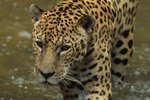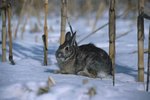
The ocelot and the jaguar are both spotted wild cats, but you wouldn't mistake one for the other. Leopardus pardalis and Panthera onca differ greatly in size and coat pattern. In one unfortunate way, they don't differ: Both species are endangered.
Big and Not-So-Big Cats
Of all wild felines, only lions and tigers are larger than jaguars. Mature jaguars can top 300 pounds, with body lengths exceeding 6 feet. By contrast, ocelots weigh only about 35 to 40 pounds in adulthood and range in length from 2 feet to 4 feet. Because of their small size, ocelots are sometimes captured or bred for the pet trade. However, they are wild animals, not oversize house cats. The legality of keeping them as pets depends on state law. States allowing them usually require permits.
Their Neck of the Woods
Although jaguars' primary habitat is now the Amazon basin, it wasn't always so. Historically, they ranged from the North American southwest throughout Mexico and as far south as Argentina, but hunting and development have reduced their range by more than half. Jaguars prefer dense forests and vegetation. Ocelots have been driven out of most of the United States, although small populations exist in Texas. Ocelots still range from Mexico southward to Argentina. Strictly nocturnal, ocelots live in treed and thickly vegetated areas.
Coat Patterns
In some ways, ocelots resemble very large tabby cats. They boast gold fur with various sizes of dark circles around tan spots. The spots can run together, forming striped patterns throughout their bodies. Their tails usually have ringed ends, similar to domestic tabbies. Ocelots have two cheek stripes, white fur surrounding the eyes and stripes from each eye running atop of the head. Jaguars resemble leopards, except that they don't just have black spots on their yellow-hued coats. Their spots are actually rosettes, dark circles surrounding the base coat with a black spot in the middle. The broad head does sport solid black spots. Completely black jaguars aren't unusual.
Catching a Bite
Jaguars hunt primarily on the ground, although they are known to climb trees and jump on prey. Their diet ranges from monkeys and snakes to deer and crocodiles and anything in between. Water-loving felines, jaguars also catch fish and turtles. Ocelots hunt by hiding in trees and thick vegetation. They obtain prey via ambush. As befits their smaller size, they hunt lesser prey than the jaguar. These include rodents, rabbits, fawns and birds.
References
Photo Credits
-
Stockbyte/Stockbyte/Getty Images
Writer Bio
Jane Meggitt has been a writer for more than 20 years. In addition to reporting for a major newspaper chain, she has been published in "Horse News," "Suburban Classic," "Hoof Beats," "Equine Journal" and other publications. She has a Bachelor of Arts in English from New York University and an Associate of Arts from the American Academy of Dramatics Arts, New York City.




